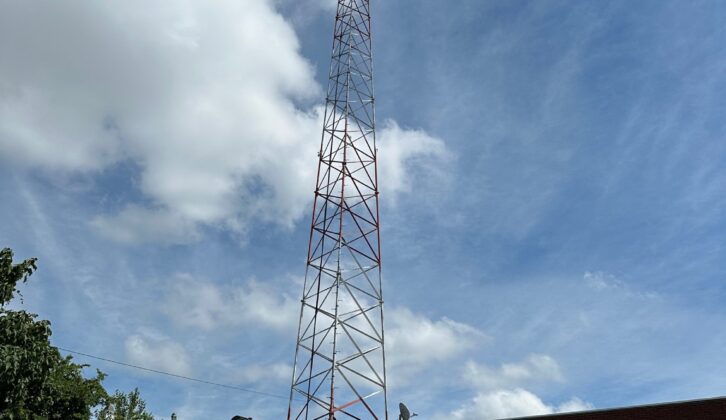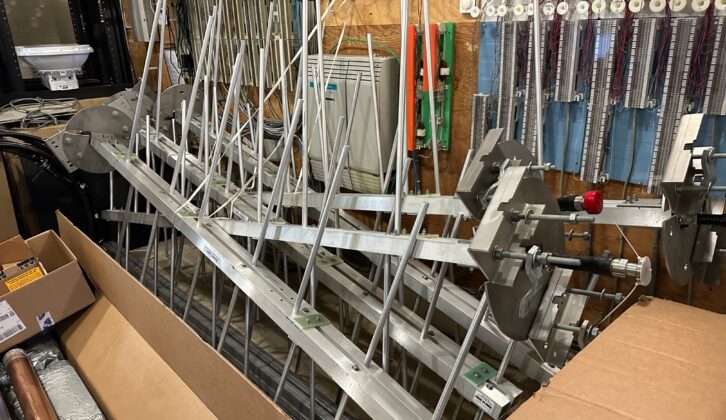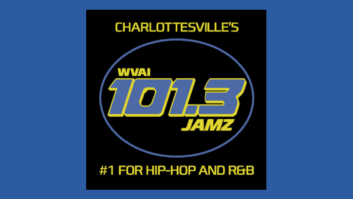Low-power WHCP(LP) on the Eastern Shore of Maryland has become full-power WHCP(FM) and an NPR member station. It upgraded from 71 watts to 14 kW and changed frequency from 101.5 to 91.7 MHz, adding 5 million drivers to its signal footprint.
We checked in with its President/General Manager Mike Starling, former director of technical operations at NPR and executive director of NPR Labs, who retired from the network in 2013 and founded the LPFM two years later.
Radio World: Mike, our readers will recall your articles about the launch and early growth of the station in Cambridge. Now it has taken another big step.
Mike Starling: The station is now a Class B1, and our goal of serving the “Mid-Shore from St. Michaels to Salisbury” is intact. Both of those communities are just at the edge of the projected 50 dBu coverage area, but we have listening reports beyond that distance both north and south, so the performance is appearing to do better than expected.
Consulting Engineer Gray Haertig, Shively and the great teams at Stellar Towers and Lane Engineering did a terrific job collaborating on designing, building and installing the massive log periodic array that is performing well in a tight pattern.
RW: What was the regulatory opportunity that prompted this change?
Starling: The November 2021 NCE window was the opportunity for this filing, and this appears to be the last full facility channel available in the NCE band in this region.
RW: How many others were involved in this particular group of mutually exclusive applications?
Starling: MX Group 49 had 13 applicants stretching from Waynesboro, Va., to Cape May, N.J. The group split in two with some late “singleton moves,” and thanks to our first-NCE service numbers, we were declared the tentative selectee on the Delmarva Peninsula.
Check out this slideshow! Click to toggle between photos.
RW: What are the major components of the air chain?
Starling: We were fortunate to have the backing of the City of Cambridge to utilize their former police department tower on very favorable terms. Our service to the community, particularly during COVID, no doubt led to the unanimous support for keeping the station based in Cambridge even though the city of license is to nearby Trappe.
The transmitter is a Broadcast Electronics FM 10S, a nice solid-state hand-me-down from colleagues at WGTS(FM). It was brokered by the amazing William Harrison at WETA(FM), who did much of the transmission plant site design and all of the copper plumbing on the 3-1/8-inch transmission line.
A PTEK transmitter provides backup service through a Dieletric switch, both previously removed from service and donated by WETA. One station’s obsolete equipment makes for a lifesaver for others, like us. It is not a dissimilar story for how WHCP(LP) was built on a shoestring in 2015 thanks to over a dozen entities across the United States donating to the cause.
The antenna is a two-level Shively 6025 three-around array, with radomes for protection during ice events here on the Mid-Shore.
With all of the old antennas removed from the police power, a 160-foot Rohn SSV, the array just fit the rigorous structural analysis performed by KCI out of North Carolina. The tower is about a quarter mile from the “flagship studios” of WHCP, the same ones used by WHCP(LP).
[Sign Up for Radio World’s SmartBrief Newsletter]
RW: When did the station throw the switch?
Starling: The transition happened at midnight on the evening of July 14. A loop running on WHCP(LP) refers listeners to 91.7 WHCP(FM), which will end on Friday, July 28.
Meanwhile down at 91.7, WHCP(FM) signed on that evening with the “Raising the Dead” overnight Grateful Dead program, followed at 6 a.m. by the live “Rockin’ Randall’s Classic Country” call-in request show, and “Weekend Edition” with Scott Simon at 9 a.m.
That was followed by six hours of a “Launch Party Too Big for a Single City,” with 12 live musicians, six in each location — the Rise Up Coffee Roasters pavilion in Easton and our studios in Cambridge.
It all went beautifully thanks to a rented MaxxKonnect system, which we now have as a priority to purchase so we can do “bonded LTE” remotes from virtually anywhere.
I told our staff that not many people realize Garrison Keillor was a local program for many years before going national on the NPR satellite. WHCP(LP) has similarly had eight years to fine tune our “out of the gate” programming lineup, having just noted our eighth anniversary on July 4.
Everyone in this business should get the thrilling opportunity to launch a new station to serve the community they have chosen to call home. It has been said WHCP stands for “We Help Cambridge Prosper,” and now that evolves to “We Help the Chesapeake Prosper” with the significant upgrade to full-service status.











